Full-time cruising brings unique rewards and responsibilities, especially when a pet is part of the journey. Gary and Melanie Tisdale have logged countless miles with their cat Hobie aboard and were kind enough to share both their personal experience and some practical advice for fellow cruisers considering life afloat with a four-legged companion.
Years ago, when Gary and I used to cruise in the 1000 Islands in the St. Lawrence River, I have a vivid recollection of seeing an older couple manhandling a pair of very large, long (and bushy) haired collies into their dinghy to take them ashore. I have to say we were both pretty gobsmacked about handling such large dogs in such a small space for even a short amount of time, not to mention the hair and hassle of getting them to shore for walks. But now that we are full-time cruisers (Maine to the Bahamas and everything in between) with our cat, Hobie, aboard, I have to say that I can’t imagine not having him on board with us as we journey. This is not to say that having a pet (or pets) aboard is something that can be taken into consideration lightly; there are many factors that can cause headaches if not planned for properly. The following is just a few suggestions on how you can make your and your pet’s life better on board.

First of all, I don’t recommend leaving home for cruising with your dog or cat without the following:
PET FOOD. Pet food is very expensive and not easy to find either, particularly if your animal needs prescription food. One can of our cat’s prescription food in America is $2.95 – in the Bahamas, it is $6 and only available at a veterinary office. Most of the cruising pet owners I know take almost all of the food they need along with them, particularly if their pet is fussy and needs a certain brand of food. If your pet eats dry food, be sure to take it out of the paper bag it comes in and store it in a plastic tub with a tight-fitting lid, or break it into smaller amounts and store in plastic bags. Better yet, vacuum seal it if you have a sealer on board. And don’t forget to pack the treats!

CAT LITTER. The first couple of years we cruised, I used a good quality clumping cat litter. Unfortunately, as cat owners know, cats are very tidy and like to cover up the evidence – the result being tiny bits of clay all over the floor which promptly got lodged into the cracks and crevices and went into the bilge. Not a good situation as we were constantly tracking it around the cabin. Then I started using the Purina Breeze Pellet System, which has been a godsend. Now I don’t have to drag huge boxes of litter around with me, since litter in the Bahamas and the Caribbean is extremely hard to find and very expensive when you do.
BASIC MEDICATIONS. Since veterinarians are few and far between in the islands, it is a good idea to ask your vet at home for some basic medications to take with you just in case of a medical issue. I would recommend a basic antibiotic, a steroid pack, a pain killer, an antihistamine and sea-sickness medication, those last two usually being very small doses of across-the-counter “human” medication, like Benadryl and Bonine. Obviously, if your pet takes regular medication, make sure you take enough with you for your trip or until you are sure you can get those medications again. They won’t be available everywhere.

PET CARRIER. It’s important to have a decent pet carrier on board (assuming you have a pet that is able to fit in a carrier!). A soft-sided collapsible one is best for storing on the boat. Hobie is particularly fond of his one with expanding sides since he has room to stretch out and see his surroundings. If you need to fly home or to a veterinarian with your animal, you don’t want to be searching for one in the islands.

LIFE JACKETS AND SAFETY GEAR. Our cat does have a life jacket – I think he has worn it twice . He tolerates it, which is more than some cats will do. Fortunately, Hobie is a fairly calm cat on the boat, and is not prone to jumping up on the dodger, boom, etc., as some cats do, so I don’t constantly feel the need to have it on him. When he is in the dinghy, he is on a leash at all times. If your animal is the type that is running all over the boat and not sure footed, I would consider leaving it on most of the time.

Our cat does wear a lighted collar at night when he is wandering around the boat. It is a USB rechargeable collar that he seems to have no problem wearing. Our friends turned us on to them when one of their cats decided to make a flying leap into the dinghy as they were pulling it up, and he missed and promptly went overboard in the pitch dark. Fortunately, the lighted collar let them see where he was and they were able to retrieve him successfully. For about $12 apiece (Amazon), they are a very good investment. I actually have one in red and one in green, which double as dinghy lights in a pinch!

Very often you will see sailboats with webbing strung from the lifelines to prevent small dogs, cats and children from slipping through and going overboard. This is something we have not done, but many cruisers swear by them. If you have a very active dog or cat, you may want to seriously consider installing some.
One of the good things about having a cat aboard rather than a dog, is that you don’t have to take the cat ashore. Having said that, Hobie does walk on a leash with a very secure harness. Cats can be trained to walk on a leash and I think that Hobie realizes it’s one way he can get off the boat. If this is something that you think you would like to do with your cat, begin their training process before you start your cruising lifestyle.


The main thing to consider when cruising with your pets are the rules, regulations and vaccine requirements of each country you will be visiting. One of the nice things about cruising in the Bahamas is that once you have checked into Customs and Immigration, you are free to wander through the 500-mile chain of islands. In the Caribbean, however, you are often jumping between different countries, all with their own requirements (not to mention fees). Some countries require only a rabies certificate, while others require more vaccinations. Very often now, countries are requiring that your animal be microchipped, and you will need to know not only the number on the microchip, but also the brand. Some countries require pre-approval and others just want to see proof of shots when you arrive. The important thing is to know before you go, especially since veterinarians are not as readily available as they are in the US and you may waste time and money trying to find a vet to accommodate your needs.
To take our cat into the Bahamas, we must fill out an application and send that in with Certificate of Vaccination showing that he has the requisite shots, along with the information on his microchip (type and number). The fee to the government for this approval has gone from $10 to $40 over the past ten years and can take as long as six months to get unless you Federal Express the application to them (about another $70). Fortunately, there are good services that will take care of this all for you, for an additional fee, of course, but it’s often well worth it. Obviously, different rules and costs apply to different countries, but the main point is to emphasize that you must make sure you adhere to the country’s rules for both importing a pet and for their vaccination requirements – you cannot treat this as a last-minute issue. I met a couple in the Bahamas who were planning on getting their dogs a series of shots, including a titer test, in Georgetown, Exuma so that they could begin their offshore voyage on to the British Virgin Islands in a few days (very strict rules, since they don’t have rabies on the islands). When I told them that they only had a vet in Georgetown once a week (if you were lucky) on a Saturday and that I seriously doubted that they would be able to get what they needed done there, they seemed extremely surprised (and not to mention unhappy) that it wasn’t something they could get done at the drop of a hat. Veterinarian services in the Bahamas and the Caribbean are few and far between so know before you go.
Others have stated “my cat doesn’t get off the boat, so we don’t bother with getting the approval”. Our first year in the Bahamas, I had to fly Hobie from the Exumas to Nassau for literally a life-threatening emergency. The airline wanted to see the stamped governmental approval before they would let me get on the plane with him, both coming and going and on two different airlines. The risk of having my pet confiscated is not something I am willing to contemplate.
A Note on Updated Regulations for Pets Returning to the US
As of August 1, 2024, dogs entering or returning to the United States must meet new requirements, depending on where they have been in the six months before entering the United States and where they received their rabies vaccines. Dog owners whose dogs have been originally vaccinated in the United States before departure AND who have not visited a high risk country prior to its return to the US simply need to fill out a form called the CDC Dog Import Form, available on the www.cdc.gov website.
There are no new requirements for cat importation at this time, unless a cat is found to be ill or dead en route to or upon arrival at a U.S. port of entry. Typically, as a returning boater, we have yet to be asked any information regarding animals on board, but it is best to be prepared just in case. There is a lot of information on the www.cdc.gov website, including a list of the high risk countries.
Lastly, and perhaps most importantly, is your pet happy on board? Gary and I were heading into lunch one day at Black Point in the Exumas, and I looked off in the distance and saw a small head moving along in the water. Recognizing it as a swimming dog, Gary and I headed over to it to see if we could help it. We stopped at a nearby boat and found out that it was their dog, but due to a recent storm in which their dinghy had flipped over, they had been unable to take the dog ashore for THREE DAYS. And the dog would not do his “business” on the boat, so off he jumped off the and started to swim to shore. We came alongside him (a large chocolate Labrador) and he happily came into the dinghy. We took him ashore after fashioning a makeshift leash and he was a very happy camper. But ultimately, this is not a fair living situation for the dog.
We know of another similar situation where our friends’ dog swam ashore at 4 am to answer nature’s call. They were horrified when they realized he was gone and were so relieved to find him on the beach. But these friends took the sensible approach and found the dog a temporary home while they cruised – they realized that the dog was not happy and did what was best for the animal, although it was very hard on them to give him up, even temporarily.
Whether you cruise with a cat or a dog, we have found that having a pet aboard is a huge stress reliever for us both. Yes – it can result in having more expenses (food, vet care, flying home if you have to leave the boat, etc.), but we consider it well worth it. And with good planning you can hopefully avoid as much extra expense as possible.



